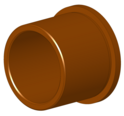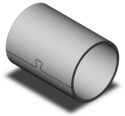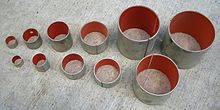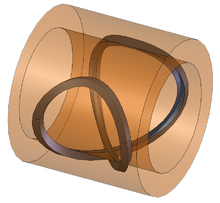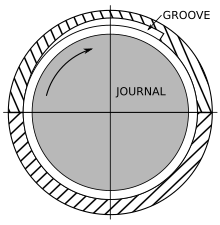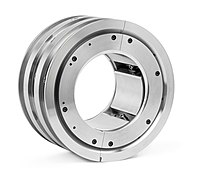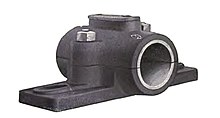A lubricant is a substance that helps to reduce friction between surfaces in mutual contact, which ultimately reduces the heat generated when the surfaces move. It may also have the function of transmitting forces, transporting foreign particles, or heating or cooling the surfaces. The property of reducing friction is known as lubricity.

A ball bearing is a type of rolling-element bearing that uses balls to maintain the separation between the bearing races.
Fluid bearings are bearings in which the load is supported by a thin layer of rapidly moving pressurized liquid or gas between the bearing surfaces. Since there is no contact between the moving parts, there is no sliding friction, allowing fluid bearings to have lower friction, wear and vibration than many other types of bearings. Thus, it is possible for some fluid bearings to have near-zero wear if operated correctly.

A bearing is a machine element that constrains relative motion to only the desired motion and reduces friction between moving parts. The design of the bearing may, for example, provide for free linear movement of the moving part or for free rotation around a fixed axis; or, it may prevent a motion by controlling the vectors of normal forces that bear on the moving parts. Most bearings facilitate the desired motion by minimizing friction. Bearings are classified broadly according to the type of operation, the motions allowed, or the directions of the loads (forces) applied to the parts.

Lubrication is the process or technique of using a lubricant to reduce friction and wear and tear in a contact between two surfaces. The study of lubrication is a discipline in the field of tribology.

In mechanical engineering, a rolling-element bearing, also known as a rolling bearing, is a bearing which carries a load by placing rolling elements between two concentric, grooved rings called races. The relative motion of the races causes the rolling elements to roll with very little rolling resistance and with little sliding.
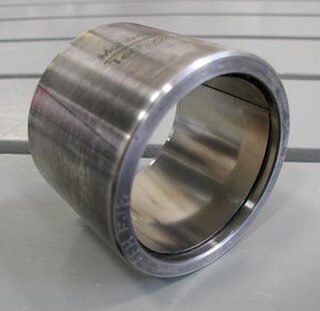
A foil bearing, also known as a foil-air bearing, is a type of air bearing. A shaft is supported by a compliant, spring-loaded foil journal lining. Once the shaft is spinning fast enough, the working fluid pushes the foil away from the shaft so that no contact occurs. The shaft and foil are separated by the air's high pressure, which is generated by the rotation that pulls gas into the bearing via viscosity effects. The high speed of the shaft with respect to the foil is required to initiate the air gap, and once this has been achieved, no wear occurs. Unlike aerostatic or hydrostatic bearings, foil bearings require no external pressurisation system for the working fluid, so the hydrodynamic bearing is self-starting.

Babbitt metal or bearing metal is any of several alloys used for the bearing surface in a plain bearing.

A pillow block bearing is a pedestal used to support a rotating shaft with the help of compatible bearings and various accessories. The assembly consists of a mounting block which houses a bearing. The block is mounted to a foundation, and a shaft is inserted, allowing the inner part of the bearing/shaft to rotate. The inside of the bearing is typically 0.025 millimetres (0.001 in) larger diameter than the shaft to ensure a tight fit. Set screws, locking collars, or set collars are commonly used to secure the shaft. Housing material for a pillow block is typically made of cast iron or cast steel.
Grease is a solid or semisolid lubricant formed as a dispersion of thickening agents in a liquid lubricant. Grease generally consists of a soap emulsified with mineral or vegetable oil.
A linear-motion bearing or linear slide is a bearing designed to provide free motion in one direction. There are many different types of linear motion bearings.
The Stribeck curve is a fundamental concept in the field of tribology. It shows that friction in fluid-lubricated contacts is a non-linear function of the contact load, the lubricant viscosity and the lubricant entrainment speed. The discovery and underlying research is usually attributed to Richard Stribeck and Mayo D. Hersey, who studied friction in journal bearings for railway wagon applications during the first half of the 20th century; however, other researchers have arrived at similar conclusions before. The mechanisms along the Stribeck curve have been understood today also on the atomistic level.
Dry lubricants or solid lubricants are materials that, despite being in the solid phase, are able to reduce friction between two surfaces sliding against each other without the need for a liquid oil medium.
In the design of fluid bearings, the Sommerfeld number (S) is a dimensionless quantity used extensively in hydrodynamic lubrication analysis. The Sommerfeld number is very important in lubrication analysis because it contains all the variables normally specified by the designer.
A stave bearing is a simple journal bearing where a shaft rotates in a bearing housing. Rather than the usual arrangement where the fixed part of the bearing surrounds most of the circumference of the shaft in one or two pieces, a stave bearing uses a large number of axial staves to support the shaft. A large housing is made with grooves running along the shaft, these grooves being filled with strips of suitable material, originally wood.

Albert Kingsbury was an American engineer, inventor and entrepreneur. He was responsible for over fifty patents obtained between the years 1902 to 1930. Kingsbury is most famous for his hydrodynamic thrust bearing which uses a thin film of oil to support weights of up to 220 tons. This bearing extended the service life of many types of machinery during the early 20th century. It was primarily outfitted on Navy ships during World War I and World War II.
Oilite is a brand of self-lubricating bearing that is made from metal alloys with pores that channel lubricants between the bearing itself and the shaft. It is manufactured from different types of material. Traditional Oilite is mostly made of copper with approximately 10% tin and up to 1% iron, while both Super Oilite and Super Oilite 16 are primarily made of iron with about 20% copper and, in the case of the latter, up to 1% graphite. Oilite is currently a registered trademark of Beemer Precision, Inc.

Spiral groove bearings are self-acting, or hydrodynamic bearings used to reduce friction and wear without the use of pressurized lubricants. They have this ability due to special patterns of grooves. Spiral groove bearings are self-acting because their own rotation builds up the pressure needed to separate the bearing surfaces. For this reason, they are also contactless bearings.
Self-lubricating chains, also referred to as lube-free chains, are commonly found in both roller chain and conveyor chain varieties, with specialty self-lubricating chains also available. These chains utilize a bush made of an oil-impregnated sintered metal or plastic to provide continuous lubrication to the chain during drive, eliminating the need for further lubrication.
A composite bearing is a bearing made from a combination of materials such as a resin reinforced with fibre and this may also include friction reducing lubricants and ingredients.




